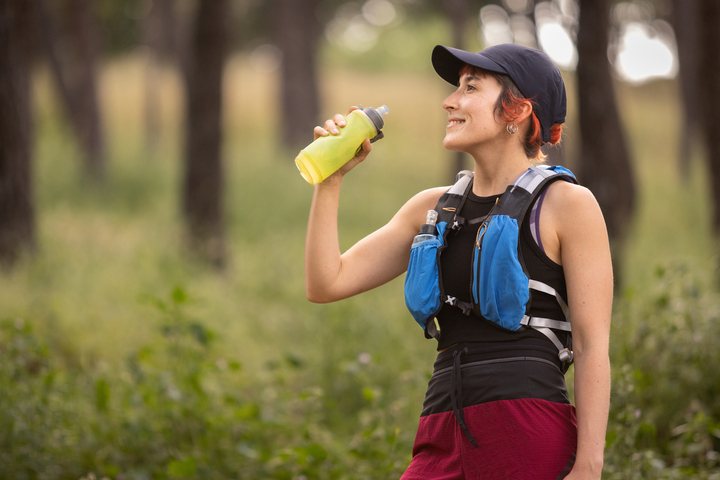Do Weighted Vests Really Help With Bone Health and Weight Loss? Here's What the Science Says Here's what you need to know before you hop on the trend

Weighted vests are a popular fitness product, especially among older women, that are believed to offer several benefits

VICTOR / Adobe Stock
- Weighted vests up the difficulty during exercise and are thought to promote weight loss, muscle growth, and bone strength.
- However, research is mixed, with some studies finding benefits and others showing no effect.
- Still, experts say weighted vests may help postmenopausal women and anyone looking to add a challenge to their workout.
Weighted vests have become a trendy fitness accessory, spotted on celebrities and promoted on social media for purported benefits like weight loss and muscle gain.
They’ve become particularly popular among older women, said Kristen Beavers, PhD, professor of gerontology and geriatrics at Wake Forest University School of Medicine—largely due to the belief that they can boost bone strength that may be lost during menopausal changes.
But that claim—and the broader health benefits attributed to weighted vests—isn’t as strongly supported by evidence as the hype around them might suggest.
One recent study conducted by Beavers and her colleagues, for example, found that wearing a weighted vest for seven hours a day for a whole year did not reduce hip bone loss among 150 obese adults actively trying to lose weight. Participants did, however, lose about 10% of their body weight—but so did two other groups (one that focused on calorie cutting and another that combined calorie restriction and resistance exercise training).
Though the findings, which were published in JAMA Network Open, may be disappointing for fans of weighted vests, researchers say they aren’t necessarily the final word on their benefits.
“This study’s findings are counter to some research, and consistent with others,” Colin Haines, MD, board-certified spine surgeon and director of research at the Virginia Spine Institute, told Health. “What’s clear is that the broader body of evidence includes both neutral and positive results.”
So, what should we make of weighted vests? Are they a waste of time or a fitness tool worth trying? Below, we break down the science.
Do Weighted Vests Boost Bone Health?
While the JAMA Network Open paper is one of the most recent studies examining the health impact of weighted vests, it isn’t the first.
In fact, research stretching back to the 1990s and early 2000s suggests the opposite about weighted vests, that they may hold promise for increasing bone density and reducing fall risks.
More recently, a 2013 study revealed that six weeks of exercising in a weighted vest stimulated bone synthesis and reduced bone resorption in postmenopausal women. Similarly, a 2015 study found that weighted vests helped postmenopausal women boost quadricep strength and bone density of the femur.
Beavers said the apparent discrepancy between these findings and her team’s newer study may be due to a different approach. For her study, participants started by wearing vests that weighed only a pound, with weight gradually added as they lost body weight.
“This is a different intervention than wearing a 15-pound weighted vest during a one-hour structured exercise bout,” she told Health. It’s also possible that participants’ weight status influenced the outcome. “That said, we didn’t specifically look at an interaction with obesity,” she added.
Do They Help You Lose Weight?
As for whether weighted vests accelerate weight loss, research is limited—but the new study isn't the only one to suggest a possible link. In a 2020 study, people who wore a heavier weighted vest for eight hours a day over three weeks lost more body fat than those who wore a lighter vest. And in a small 2025 study, wearing a weighted vest in combination with restricting calories appeared to help prevent weight regain after a weight-loss program.
So, Should You Wear a Weighted Vest?
According to both Beavers and Haines, a picture is emerging of weighted vests as a potentially useful tool for benefits like weight loss and bone density—but more research is necessary to know for sure.
Some groups may reap more advantages than others from this type of fitness wear. Haines said he’d recommend weighted vests to both postmenopausal women and anyone seeking a more efficient, challenging resistance workout.
“The general guideline is to keep the vest weight at or below 10% of your body weight,” he said. “Listen to your body and adjust your workout accordingly.”
Edited by Health with a background in health, science, and investigative reporting. Previously, she wrote full time about parenting issues for the app Parent Lab. Before that, she worked as a reporter for National Geographic covering wildlife crime and exploitation." tabindex="0" data-inline-tooltip="true"> Jani Hall Jani Hall
Jani Hall is a news editor for Health with a background in health, science, and investigative reporting. Previously, she wrote full time about parenting issues for the app Parent Lab. Before that, she worked as a reporter for National Geographic covering wildlife crime and exploitation.
learn more
Read more:
Jani Hall
Jani Hall is a news editor for Health with a background in health, science, and investigative reporting. Previously, she wrote full time about parenting issues for the app Parent Lab. Before that, she worked as a reporter for National Geographic covering wildlife crime and exploitation.
learn more
Read more:
This story originally appeared on: Health News - Author:Sarah Garone


















